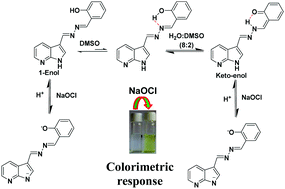Reversible detection of hypochlorite using the deprotonation–protonation strategy: a search for new building blocks†
Abstract
A variety of building blocks having ‘acidic protons’ and potential to undergo self-assembly have been synthesized for the reversible detection of hypochlorite in aqueous media using deprotonation–protonation as the detection strategy. Among the synthesized building blocks, AIE active supramolecular assemblies of ESIPT active salicylaldehyde probe 1 having a pKa value of 3.20 exhibit a highly sensitive response towards hypochlorite with a detection limit in the nanomolar range (50.2 nM). The sensitive response of the assemblies towards ClO− is attributed to their high acidity and formation of more ordered assemblies after deprotonation. Other way around, assemblies of indolium probe 5 having a high pKa (6.85) value show hypochlorite induced emission enhancement with a detection limit in the micromolar range (38 μM). This reasonably good detection limit is attributed to the hypochlorite induced sensitive and sharp emission changes due to the generation of ordered assemblies of deprotonated species. To sum up, the work being presented in this manuscript demonstrates the importance of ‘acidic protons’ and formation of ordered assemblies of deprotonated species for reversible, colorimetric and fluorogenic detection of hypochlorite using the deprotonation–protonation strategy. Furthermore, the real time application for ‘on site’ detection of hypochlorite has been demonstrated by using the ‘dip strip’ prepared from the solution of assemblies of probe 1. Unprecedented, the present study further reveals the potential of ESIPT-AIE active probe 1 as an antioxidant for suppressing sodium hypochlorite induced oxidative transformation under lab conditions and protection of cells from hypochlorite induced cell death in L-929 cell lines.



 Please wait while we load your content...
Please wait while we load your content...